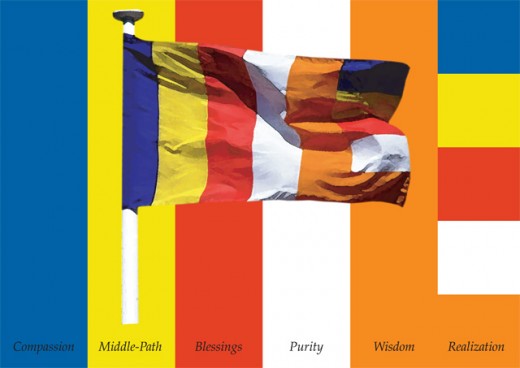The International Buddhist Flag
The International Buddhist Flag

The Buddhist Flag was first hoisted in Sri Lanka on Wesak Day (28 April) in 1885, when the country was still under colonial rule. The majority Sinhalese Buddhist population then felt discriminated against by the colonial authorities when carrying out their religious activities, as well as pressurized by relentless evangelism. The Buddhists needed an icon to peacefully rally around, and hence, the Buddhist Flag was initiated.
At the World Fellowship of Buddhists Conference in 1952, the flag was unanimously adopted by the international delegates as the universal symbol of Buddhist faith. Since then, it has been flown at important Buddhist events, especially on Wesak Day.
When devotees gaze at the Buddhist Flag, they see a potent symbol of faith, global unity and world peace. The colours on the flag exemplify the Buddhist ideal of harmony between all nationalities and beliefs, and the universally-accepted, all-encompassing truth of Dhamma.
Standard Colours & Design
The design of the standard Buddhist Flag comprises six vertical coloured stripes of equal width – blue, yellow, red, white, orange, and a combination of the five colours as the sixth. For graphical reasons, the sixth stripe is shown as five horizontal bars comprising the other colours.
These six-coloured rays (Pali : ramsi) were said to have emanated from the Buddha when He attained Enlightenment – the great realization of universal truth. Each of these colours represents a particular salient quality of Buddhism.
 Blue Nīla
Blue Nīla
Blue symbolizes the quality of peace, unconditional loving-kindness (mettā) and compassion (karunā). The Buddha realized the Truth not only for His own liberation but also out of compassion for all beings. Therefore, our practice of Dhamma is also based on loving-kindness and harmony with others, and out of compassion for all suffering ones.
 Yellow Pīta
Yellow Pīta
Yellow symbolizes the Middle-Path that avoids the futility of self-indulgence and self- mortification. The Middle-Path is the amalgation of 8 noble qualities – Right Understanding, Right Thought, Right Speech, Right Action, Right Livelihood, Right Effort, Right Mindfulness, and Right Tranquility.
 Red Lohitaka
Red Lohitaka
Red symbolizes the blessings of living by the principles of Dhamma. We obtain the blessings of generosity, virtue, fortitude and wisdom by practising Dhamma.
 White Odāta
White Odāta
White symbolizes the purity of Buddha’s Teaching. The Blessed One’s Dhamma is timeless, perfect and complete. He taught beings the proven and infallible way to achieve liberation from suffering.
 Orange Manjettha
Orange Manjettha
Orange symbolizes the Wisdom of Buddha’s Teachings. With proper learning, practice and realisation of Dhamma, we attain deep insights and wisdom that are profound, life-changing and liberating.
 Combination of five colours
Combination of five colours
The sixth vertical stripe is termed “Pabhassara”- the ‘resplendent glory’. It is the successful culmination of our practice as a Buddhist, having started out of compassion for oneself and all beings, we follow the Middle-Path of modesty and moderation. After which, we obtain the great blessings of practice and see the purity and truth of Dhamma. Insights arose and wisdom is obtained, thereby freeing us from all afflictions and suffering!

